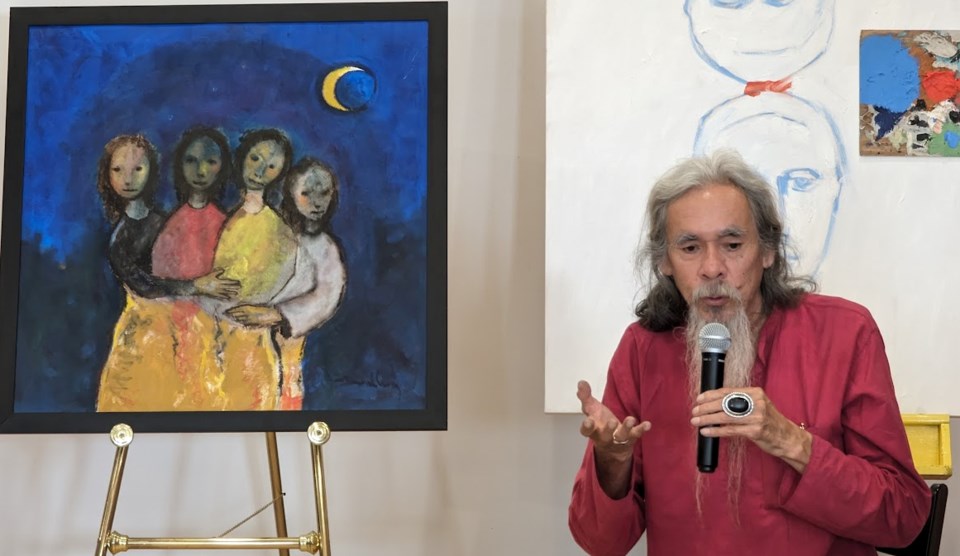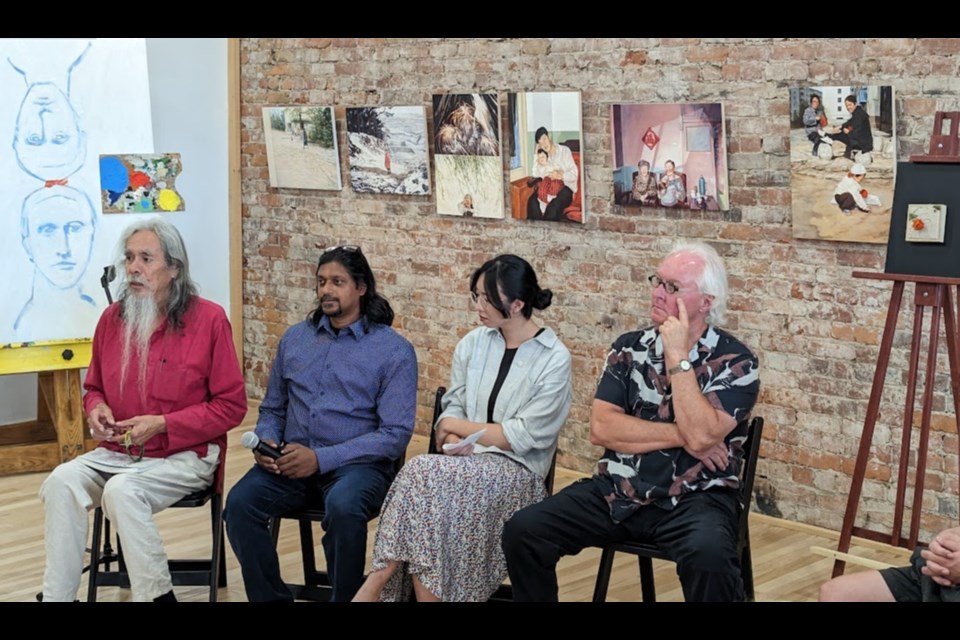“How do you get wisdom? Using all the teachings together with experience of life and knowledge is wisdom. Do you have self control to slow down your choices? You can make decisions without much thought or consequences. Wisdom takes time,” explained Xavier Fernandes, a Pakistani-born artist who has lived in Orillia since the age of 11 months.
Wisdom, the final teaching of the Seven Grandfather Teachings project, presented by Orillia District Arts Council (ODAC), happened at Creative Nomad Studios on Saturday.
Throughout the year, from September 2022, four artists from different backgrounds and cultures took on the task of interpreting each of the seven teachings through each of their artistic mediums.
The four artists are Xavier Fernandes, Ted Fullerton, Paul Shilling, and Julie Tian. The seven teachings are bravery, honesty, truth, love, humility, respect, and finally, wisdom. Since this was the final presentation in the series, each artist had all of their works in this series on display at the gallery.
The teaching of wisdom is commonly thought to be the final product of all of the other teachings combined. As each artist talked about wisdom, and their piece, this common theme and others began to emerge.
Fernandes’s work was a photograph of a beautiful, small, shallow bowl, with holes all around the edges of it. He described how, when the bowl developed a crack, he was able to take that flaw and make something beautiful out of it. Fernandes had the original bowl on display as well.
“The weakness of the piece is still there," he explained. "But now the delicateness is the feature and not a flaw. Seeing how a flawed piece can transform and become so positive and beautiful, means it will not be discarded.
"Everything is beautiful. We are all beautiful people. We need to take care of each other. With wisdom we are able to see how we are all delicate, beautiful people, joined together on this journey of life, all connected together," said Fernandes.
"But if you apply pressure in the wrong place, some of the weaker spots, it can destroy the whole piece. So, there is a balance there. As people we need to use all the teachings together,” he finished.
This theme, of working together, and of people of being inherently beautiful, continued with First Nations artist Paul Shilling’s words and work. Shilling’s piece depicted the four sacred mothers, Brown, Black, Red, and Yellow, and talked about how they gave birth to sons and daughters: eight billion beings.

“We are all beautiful people," said Shilling. "We are all the same, inside. We have been taught to hate, taught to have prejudice. We need to cast off this blanket of shame that is covering our souls, cast off the beliefs that are taught to us, cast off the fear, and come together.”
Julie Tian, a young, queer, Chinese-Canadian artist, made the journey back to Orillia again from Toronto to participate in this last presentation. Her embroidered work depicted the chokecherries she remembered from her childhood in China, growing along near the railway where she liked to play.
She taught the attentive audience about the history of the railway in Canada, which was a weapon that helped the settlers to take over the land from the First Nations people, while also exploiting the work and the people of China, who came to work on the railway.
Tian reminded the audience that 100 years ago the government of Canada brought in the Chinese Exclusion Act, and along with that, a head tax on Chinese immigrants, which meant decades of trauma and familial separation to many Chinese.
“And for these reasons, railways, railroads remain a symbolic sign of protest for Indigenous people to this day," said Tian. "I chose to talk about this history because a part of the teaching of wisdom is having knowledge of those that come before you and being receptive to seeing that and understanding it from all around you; its past and your role in it in a systemic way, and choosing to move forward with all of the other teachings.
"And so, as I look for the bright red fruit, driving by the train tracks, wisdom is seeing the tracks, but choosing to leave those tracks and move forward in a new way.”
Ted Fullerton, a white artist who was head of Georgian College's School of Design and Visual Art, admitted freely that he comes from a place of privilege.
“I am white, I grew up in and am still in the upper middle class, I haven’t had the experiences of my colleagues,” he said. “During this process, I have learned much from my colleagues, and had many 'aha' moments which I hope to take forward in this journey of life."
The other artists agreed they have learned much from being part of this journey, and from each other. “I am going to miss these people,” Tian mused. “I have learned a lot and have really enjoyed this project.”
Following the artists’ formal presentations, questions were taken from the audience of about 80 people. Although slow to start, the questions soon became very personal, delving deep into the work of Truth and Reconciliation, and into each artist’s lived experience, as the audience members strove to understand, to be open, and to be part of a healing journey.
Fernandes shared a deeply personal story of his youth, of prejudice from a neighbour child, and how Fernandes was able to help teach that boy, just by walking by and saying 'Hi', that the truth he had learned from his families was not the truth.
“Sure, I got shoved over sometimes,” said Fernandes. “But when he was alone, not with his friends, eventually sometimes he would say 'Hi' back. And when I saw him again in high school, he was different, he had learned. He didn’t shove me over any more.”
Afterwards, audience members mingled and talked about what they had learned, and what they wanted to do, moving forward.
“Being a real ally is so important,” said attendee Carol Benedetti. “Speaking up, thanking people when they correct you, and always listening. What we used to say and do isn’t the right thing, any more.”
ODAC board member Dennis Rizzo, who helped facilitate the project, said he was very happy with how it came together.
“These artists were so good to work with,” he said. “It was a healing and learning experience for everyone who came out.”
The artists’ works will journey to Waterloo in the fall, to the Martin Luther University College, where they will be on display from Sept. 11 to Nov. 30. There will be a presentation by the artists on Sept. 30, National Day of Truth and Reconciliation. Follow ODAC social media for more information.
